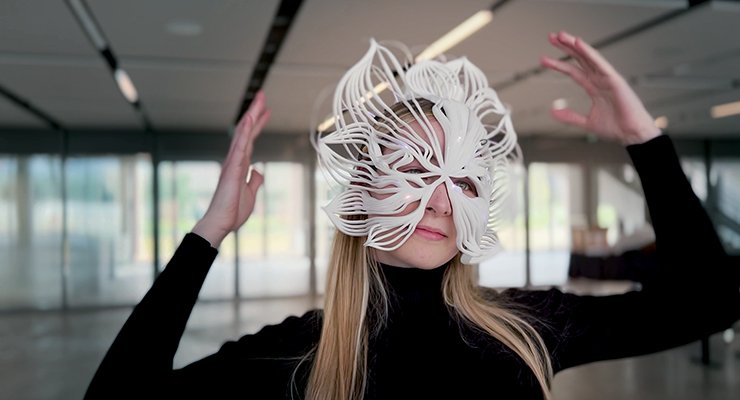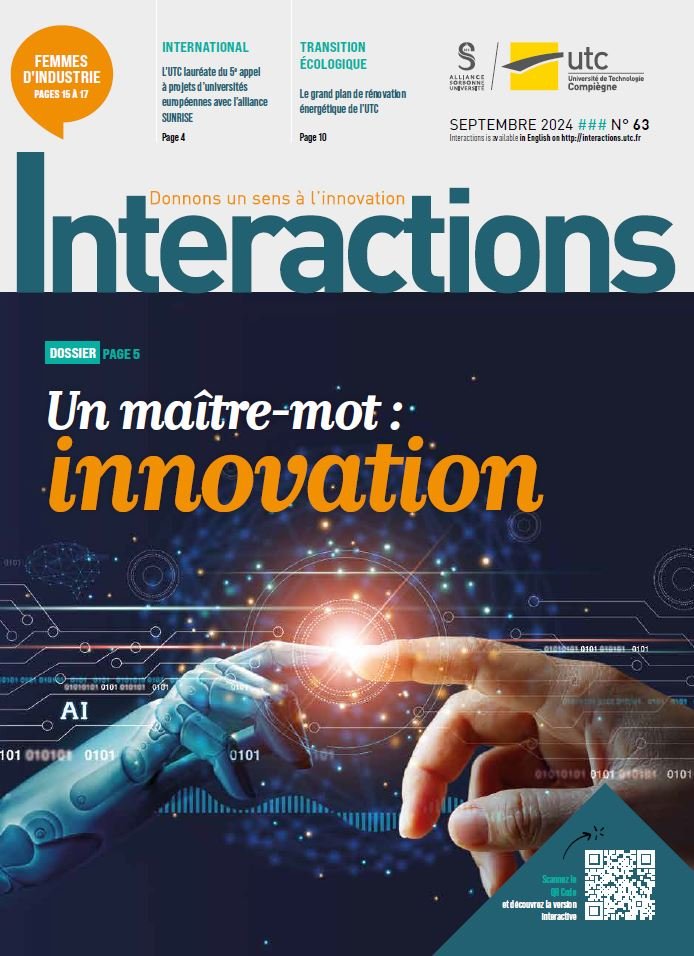Research scientist — cum – artist

Ninon Lizé Masclef is the first artist “in residence” as we say, at the 3DEXPERIENCE Lab, the innovation centre of Dassault Systèmes France. She is simultaneously in charge of scientific research with the UK start-up Ontbo. Her research is specialised in the analysis of emotions and music to develop brain-computer interfaces.
Aged 25, Ninon Lizé Masclef has already designed an emotion sensor mask with CATIA XGenerative Design, using a 3D scan of her head to integrate an EEG sensor and fibre optics. She had never used this software & hardware before. She was trained and assisted by the 3DEXPERIENCE Lab team and Sébastien Rosel — Technical Director at Dassault Systèmes. The mask was printed using powder sintering (aka ‘SLS’ an acronym for Selective Laser Sintering). The EEG sensor is integrated into the mask, with an electrode targeting the human frontal lobe. «The signal is analysed to derive peaks in the gamma, beta, alpha, theta, delta bands, as well as attention and relaxation levels. The colours of the optical fibres change according to these peaks of activity and light animations occur, such as flickers or ripples when the person is very attentive or meditating,» explains the research scientist. She certainly has a very original background.
She followed the Humanities and Technology (Hutech) course at UTC-Compiegne, and pursued majoring in Computer Engineering branch, with Data Mining as her elective specialty. «I was interested above all in the interdisciplinary nature of Hutech. I saw it as an effective way of reconciling my attraction for the humanities, in particular philosophy, and the sciences. Indeed, as I had done a Baccalaureate L specialising in visual arts and music. In fact, I changed my final lycée year, going from “première S” to “terminale L” in visual arts,» she says. It was my high school philosophy teacher who advised me to do the Humanities and Technology course at UTC. What interests me in engineering is being able to think about the worlds that are possible with technology, to imagine technologies that transform society”. »
Developing research and art
This mask was her final project for the «Fabricademy: Textile and Technology Academy» programme at the Fablab of the University of Paris-Saclay. An intensive programme that mixes art and science and where she learned to use 3D printing, laser cutting, milling and designing of printed circuit boards (PCB) on textile and skin, soft robots, biomaterials. «I have wanted to create a brain-computer interface for a long time. During the programme, I made a first interface from a Star Wars toy that contains an EEG sensor used to make a hologram move with thought. I developed a script to “hijack” in essence, the function of this toy to compose music with my brainwaves. Then I tried to build my own sensor circuit,» she adds. “When I was designing the circuit, I realised that an EEG is based on a mechanism used to for amplify the brain’s electrical activity, and I found a kind of poetry in that area. I got the idea for the shape of the mask from the electrical fields from the brain found at the surface of the head. In a way, I am trying to amplify, to increase our emotions, and at the same time, I amplify the electrical activity to capture those same emotions”.
Ninon Lizé Masclef has imagined a series of masks based on the principle of biofeedback, for example with the heartbeat and facial muscles. In this way, she could have a finer characterisation of emotions. During her year-long residency at Dassault Systèmes’ 3DEXPERIENCE Lab, she planned work on several art projects, including one on dreams. «I set up a protocol to record my EEG signal during sleep and annotate my dreams when I wake up in order to train a model to recognise objects in the dream content. The ultimate goal is to use artificial intelligence models to generate 3D scenes from dreams,» concludes the research scientist, who would like to defend a PhD thesis in computer science combining deep learning with neuroscience or art. And why not, create her own AI and Art research studio.




